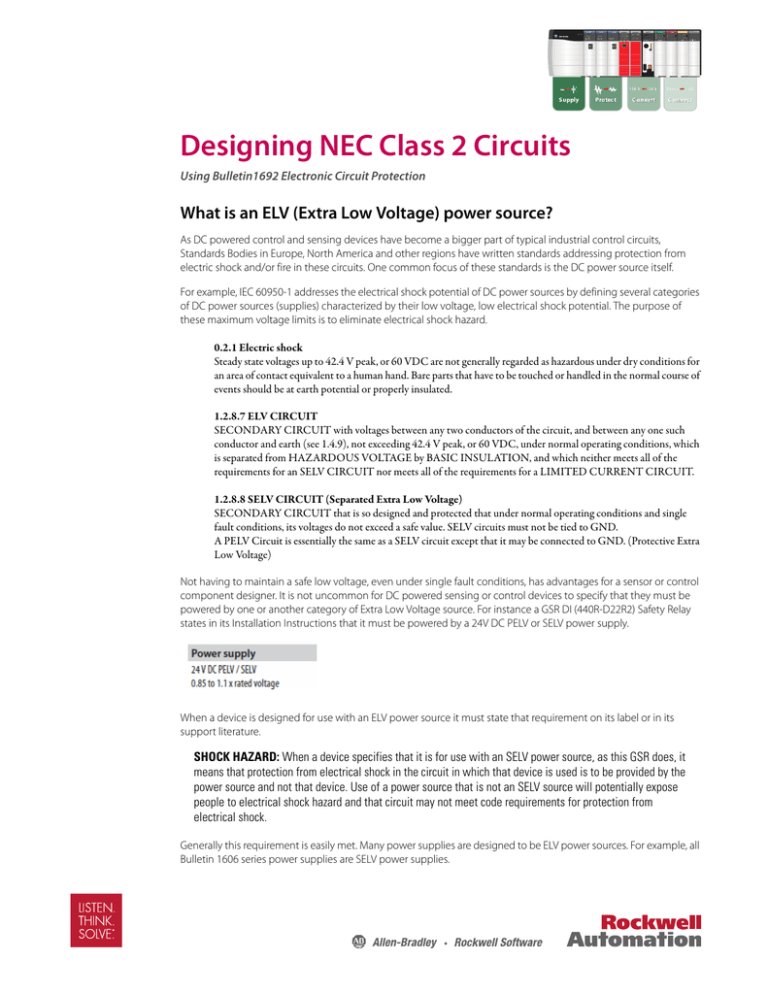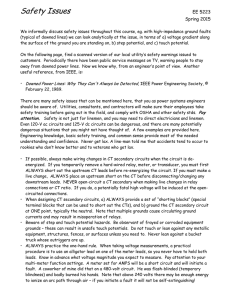
Designing NEC Class 2 Circuits
Using Bulletin1692 Electronic Circuit Protection
What is an ELV (Extra Low Voltage) power source?
As DC powered control and sensing devices have become a bigger part of typical industrial control circuits,
Standards Bodies in Europe, North America and other regions have written standards addressing protection from
electric shock and/or fire in these circuits. One common focus of these standards is the DC power source itself.
For example, IEC 60950-1 addresses the electrical shock potential of DC power sources by defining several categories
of DC power sources (supplies) characterized by their low voltage, low electrical shock potential. The purpose of
these maximum voltage limits is to eliminate electrical shock hazard.
0.2.1 Electric shock
Steady state voltages up to 42.4 V peak, or 60 VDC are not generally regarded as hazardous under dry conditions for
an area of contact equivalent to a human hand. Bare parts that have to be touched or handled in the normal course of
events should be at earth potential or properly insulated.
1.2.8.7 ELV CIRCUIT
SECONDARY CIRCUIT with voltages between any two conductors of the circuit, and between any one such
conductor and earth (see 1.4.9), not exceeding 42.4 V peak, or 60 VDC, under normal operating conditions, which
is separated from HAZARDOUS VOLTAGE by BASIC INSULATION, and which neither meets all of the
requirements for an SELV CIRCUIT nor meets all of the requirements for a LIMITED CURRENT CIRCUIT.
1.2.8.8 SELV CIRCUIT (Separated Extra Low Voltage)
SECONDARY CIRCUIT that is so designed and protected that under normal operating conditions and single
fault conditions, its voltages do not exceed a safe value. SELV circuits must not be tied to GND.
A PELV Circuit is essentially the same as a SELV circuit except that it may be connected to GND. (Protective Extra
Low Voltage)
Not having to maintain a safe low voltage, even under single fault conditions, has advantages for a sensor or control
component designer. It is not uncommon for DC powered sensing or control devices to specify that they must be
powered by one or another category of Extra Low Voltage source. For instance a GSR DI (440R-D22R2) Safety Relay
states in its Installation Instructions that it must be powered by a 24V DC PELV or SELV power supply.
When a device is designed for use with an ELV power source it must state that requirement on its label or in its
support literature.
SHOCK HAZARD: When a device specifies that it is for use with an SELV power source, as this GSR does, it
means that protection from electrical shock in the circuit in which that device is used is to be provided by the
power source and not that device. Use of a power source that is not an SELV source will potentially expose
people to electrical shock hazard and that circuit may not meet code requirements for protection from
electrical shock.
Generally this requirement is easily met. Many power supplies are designed to be ELV power sources. For example, all
Bulletin 1606 series power supplies are SELV power supplies.
2 Designing NEC Class 2 Circuits
What is a NEC Class 2 DC power source?
The “National Electrical Code” (NFPA 70) also defines special requirements for safe, low voltage circuits. The NEC
refers to such circuits as Class 2 circuits.
To eliminate electrical shock hazard the standard in Article 725, requires that low voltage DC circuits have a
maximum voltage limit essentially the same as that defined in IEC 60950-1. The big difference is that, to eliminate fire
hazard, Article 725 also requires that the maximum power potential of these circuits to be limited to 100VA. As a
consequence of the 100VA max capability requirement, power sources meeting Class 2 requirements generally have
lower current capability than non-Class 2 power sources.
WARNING: The NEC does not consider using a higher current capable power source, fused for 100VA, to be an
acceptable Class 2 power source.
All power supplies with an output rated at 100VA or less are not necessarily Class 2 power supplies. UL has specific
tests when certifying a Class 2 power source.
Several Bulletin 1606 series power supplies are Class 2 rated. The maximum current supplied by a 24V DC Class 2
1606 power source is 3.9 A (1606-XLP95E @ 24.5 VDC).
Similar to the case of developing devices for use with ELV power sources, developing component devices for use in
Class 2 circuits has advantages for the designer. Such devices are not required take protection from electrical shock
hazard or fire hazard into account in their design as they would when designed for use with standard power sources.
Devices designed for use in Class 2 circuits can often be smaller in size and use smaller gauge conductors. Relieved
of primary responsibility of preventing fire hazard, circuitry can often be simplified. Most DC powered sensors and
many controls from Rockwell Automation or any other provider are designed for use in circuits with Class 2 power
sources.
In the United States the NEC provides guidance for enforcement by local authorities while UL defines the design
characteristics and often conducts the testing which determines whether a device is in compliance with standards
and receive, if in compliance, UL certification. Other independent testing parties may also provide certification to a
specific standard.
Two areas that have always been of concern to UL are electrical shock hazard and fire hazard. Since the power source
of a Class 2 circuit is responsible for the ensuring that the maximum voltage and the maximum current allowed in
the circuit are not exceeded. Devices that are designed for use in Class 2 circuits benefit from simpler and quicker
testing to achieve UL certification than devices designed for use with “standard” power sources.
Designing NEC Class 2 Circuits 3
All devices that are UL Certified for use with Class 2 power sources must be state so on their labels. It is not an option.
Once a device is UL certified for use in Class 2 circuits that device can only be used with a Class 2 power source to
maintain compliance with its UL certification.
SHOCK HAZARD: When a device specifies that it is certified for use with a Class 2 power source protection
from electrical shock and fire hazards in that circuit must be provided by the power source. Use of a power
source that is not a Class 2 source will potentially expose people to electrical shock and fire hazard and that
circuit may not meet the NEC code requirements.
Class 2 Strategies
When must a Class 2 power source be used?
Class 2 is exclusively a NEC category. The short answer for the “…when to use a Class 2 power source?” question is for
any circuit powering any device that is UL certified with a requirement of a Class 2 power source.
Most DC sensors, from any provider, when UL certified, are certified for use in Class 2 circuits (e.g. powered by a Class
2 Power Source).
Most Rockwell Automation DC sensors including IO Link, Zone Control and DeviceNet sensors are UL certified for
Class 2 circuits. SensaGuard products are UL Certified for Class 2 circuits. Safety Relays, the MSR42 for instance, are UL
Certified for Class 2 circuits. Many condition sensing devices from Rockwell Automation are UL certified with Class 2
circuits.
Other product manufactures receive certification with the Class 2 powered source requirement. They should be
marking that requirement on their product(s) and including that requirement in the product information.
Whenever the connected component(s) require a class 2 circuit, it is the installer’s responsibility to power that device
with a Class 2 power source.
GUIDANCE: When there is application of components in regions other than US, the NEC Class 2 requirements do
not carry any authority. However, the application designer may wish to consider the component product design
requirements when designing power sources for those components, wherever they are applied.
There are two basic scenarios for implementing Class 2 power sources into a system: Class 2 power sources can be
designed in from the beginning or a Class 2 source can be integrated into an existing system. Rockwell Automation
has products suited for either situation.
In the case of a new system using Class 2 power sources, when required, from the start is simplest. Due to the
relatively limited power available from a Class 2 source it is not uncommon for a new system to include both Class 2
and standard non-Class 2 power sources. While non-UL Certified Class 2 DC powered devices may be included in a
Class 2 circuit; generally the Class 2 power source is sized to handle the power requirements of only the Class 2
devices only. A standard supply with a higher current capacity is provided to power devices that do not require a
Class 2 power source. The Bulletin 1606 XL series has a wide selection of Class 2 and standard power supplies.
There can be a third way. In many instances the combination of a larger “standard” power supply and the Bulletin
1692 ECP may offer a superior alternative.
Bulletin 1692 ECP Allows for Optimal Efficiency
A single Cat. No. 1692-ZRCLSS module, using a single standard, SELV, 24VDC power source for its power input,
provides four 24V DC, NEC Class 2 power circuits. In this case the SELV power source provides the shock hazard
protection while the 1692 provides the power limit protection.
If more than four branches are required, multiple Bul.1692 modules can be connected to the power supply.
Bulletin 1692 Features:
• An integrated On/Off - Reset momentary push button and galvanically isolated, optocoupled
•
•
•
•
provision for adding, if desired, a remote On/Off - Reset momentary push button.
An “OK” relay contact to provide status feedback - This contact is closed when the input voltage is
within spec and all output branches are operating within power limits.
A Green input status LED - This LED is illuminated when the input voltage is above the required
21V. The Green LED blinks when the “1692”’s input protection circuit has been activated to prevent
the output voltage from dropping below 21V or when the output branches have been shut down due to
unacceptably low input voltage.
Four Red Failure LEDs – All four output channels are shut down whenever the output current of any
channel exceeds its limit. The Red Failure LED of any channel whose output current exceeded its limit
blinks. The Red failure LED of any channel whose output current did not exceed its limit is illuminated
but does NOT blink. When the output channels were shut down to too low input voltage all four Red
failure LEDS are illuminated.
A Synchronization Bus connection – When multiple 1692s are used, powered by the same supply
connecting the 1692’s Sync terminals aids fault analysis. When one of the 1692s shuts down, due to
insufficient input supply voltage, all other Sync connected 1692s shut down as well. When one of the
1692s shuts down because one of its output channels drew excessive current only the 1692 whose
output channel drew excessive current will shut down.
Allen-Bradley, Rockwell Software, Rockwell Automation, SensaGuard, and DeviceNet are trademarks of Rockwell Automation, Inc.
Trademarks not belonging to Rockwell Automation are property of their respective companies.
Publication 1692-WP001A-EN-P - July 2012
Copyright © 2012 Rockwell Automation, Inc. All rights reserved. Printed in the U.S.A.




